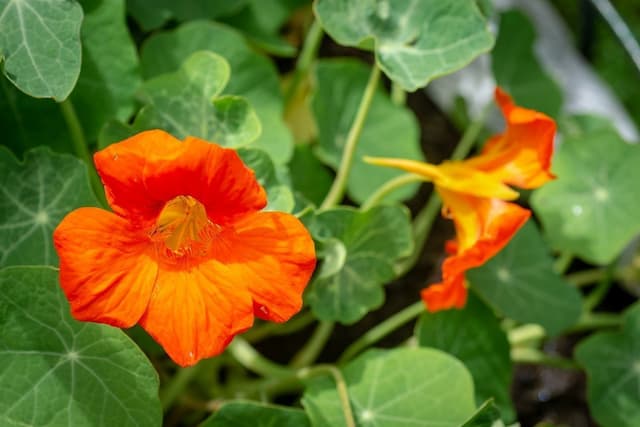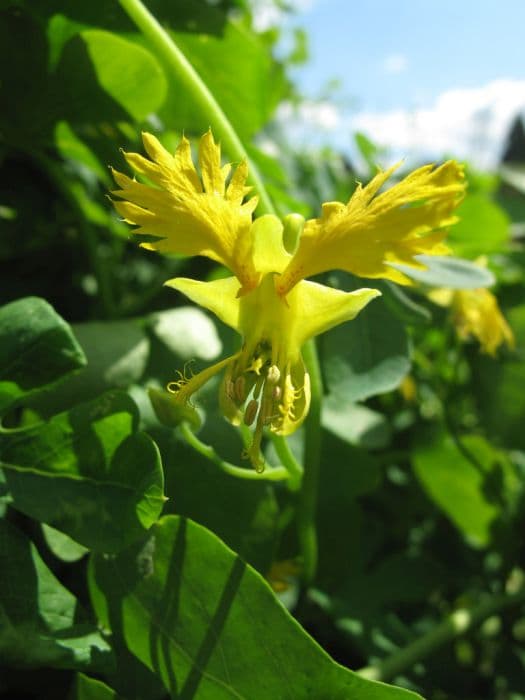Flame flower Tropaeolum speciosum

ABOUT
The plant commonly known as flame flower is a striking and ornamental vine. It's distinguished by its vivid red, trumpet-shaped flowers, which are a key feature that draws both the human eye and numerous pollinators. The leaves of the flame flower are rounded and have a lily pad-like appearance, often providing a lush green backdrop that contrasts beautifully with the fiery hue of the blooms. In addition to its attractive foliage, the plant bears blue-black berries that are favoured by some bird species. The overall look of the flame flower is one of vibrant color and delicate balance, with its blossoms, which are typically adorned with a spurs on their backsides, providing an impressive display that can add a touch of drama to any garden setting. Its climbing nature allows it to spread across structures, such as fences or walls, adding vertical interest and a splash of color where it is allowed to thrive.
About this plant
 Names
NamesSynonyms
Flame Flower, Flame Nasturtium, Scottish Flame Flower, Climbing Nasturtium
Common names
Tropaeolum speciosum
 Toxicity
ToxicityTo humans
The Scottish Flame Flower, Tropaeolum speciosum, is generally considered non-toxic to humans. While consumption in large quantities may cause stomach upset, it is not known for serious toxicity or hazardous health consequences. However, it's always best to exercise caution and avoid ingesting plants not commonly regarded as food items, as individual allergies or sensitivities may exist.
To pets
The Scottish Flame Flower, or Tropaeolum speciosum, is not commonly known to be toxic to pets. However, like with humans, it is generally advisable not to let pets consume plants that are not part of their typical diet. Ingestion could potentially lead to mild gastrointestinal upset due to the novelty and fiber content, but there are no well-documented toxic effects related to this specific plant and pets.
 Characteristics
CharacteristicsLife cycle
Perennials
Foliage type
Deciduous
Color of leaves
Green
Flower color
Red
Height
10 feet [3 meters]
Spread
6 feet [1.8 meters]
Plant type
Climber
Hardiness zones
9
Native area
Chile
Benefits
 General Benefits
General Benefits- Ornamental beauty - Tropaeolum speciosum, commonly known as flame flower, has vivid red, trumpet-shaped flowers that can enhance the aesthetic appeal of gardens and landscapes.
- Low maintenance - Flame flower is considered easy to grow and requires minimal upkeep once established, making it suitable for novice gardeners.
- Pollinator attraction - The bright flowers of the flame flower are good at attracting pollinators such as bees and hummingbirds, which are beneficial for the pollination of surrounding plants.
- Edible parts - The leaves and flowers of flame flower are edible and can be used in salads, adding a peppery flavor similar to watercress.
- Climbing growth habit - As a climbing plant, flame flower can be used to cover trellises, fences, and walls, providing a natural, green screen for privacy or decoration.
- Seasonal interest - Flame flower blooms from mid-summer to early fall, providing color when many other plants have finished flowering.
- Companion planting - Flame flower can be used effectively in companion planting due to its ability to climb and coexist with other plants without overshadowing them.
 Medical Properties
Medical PropertiesThis plant is not used for medical purposes.
 Air-purifying Qualities
Air-purifying QualitiesThis plant is not specifically known for air purifying qualities.
 Other Uses
Other Uses- As a natural dye: The bright red flowers of Tropaeolum speciosum, also known as flame flower, can be used to create a natural dye for fabrics and other materials.
- Garden aesthetics: Flame flower's vivid red blossoms and lush green foliage are ideal for enhancing the visual appeal of garden arches, walls, and fences.
- Companion planting: Gardeners plant flame flower alongside vegetable crops to attract beneficial insects and deter pests, without relying on chemical pesticides.
- Floral arrangements: Fresh or dried, the vibrant flowers of the flame flower add an exotic touch to bouquets and other floral displays.
- Culinary garnish: The flowers of the flame flower are edible and can be used to add color and a peppery flavor to salads and desserts.
- Photography subject: Due to its striking appearance, Tropaeolum speciosum is often used as a photogenic subject for both professional and amateur photographers.
- Educational tool: Flame flower can be used in educational settings to demonstrate plant climbing methods and pollination by insects.
- Symbolic uses: In some cultures, the flame flower may be used symbolically in ceremonies or traditions owing to its vibrant color and rarity.
- Seasonal decoration: Its autumn-persistent seed pods and seasonal change in foliage make it suitable for use in fall-themed decorations and displays.
- Cover for utility boxes: Tropaeolum speciosum is sometimes planted to naturally camouflage utility boxes and other unsightly structures in the garden.
Interesting Facts
 Feng Shui
Feng ShuiThe Flame flower is not used in Feng Shui practice.
 Zodiac Sign Compitability
Zodiac Sign CompitabilityThe Flame flower is not used in astrology practice.
 Plant Symbolism
Plant Symbolism- Conquest and Victory: Tropaeolum speciosum, commonly known as Flame flower, is derived from the Greek word "tropaion" which means "trophy." The plant's association with triumph in battle comes from its resemblance to a classical trophy, with its round shield-like leaves and helmet-shaped flowers.
- Strength and Resilience: The vibrant red flowers of the Flame flower symbolize energy and the ability to overcome challenges, reflecting the plant's vigorous growth habit and its capacity to thrive in various conditions.
- Patriotism: In Scotland, where the Flame flower is often seen in gardens, it can symbolize national pride due to its bright red color, which resonates with the traditional tartan hues.
 Water
WaterThe Flame Flower requires consistent moisture and should not be allowed to dry out. Water it thoroughly once a week with about 1 gallon of water, making sure to soak the soil around the roots. During particularly dry periods or in warmer climates, you may need to increase watering frequency to twice a week. Reduce watering in the winter when the plant is dormant. Avoid overhead watering to minimize leaf wetness and reduce the risk of fungal diseases.
 Light
LightThe Flame Flower prefers partial shade, particularly sheltered from the intense heat of the afternoon sun. An ideal spot would be one where it receives bright, indirect sunlight for most of the day, such as a position under a tree that provides dappled sunlight. Direct morning light is generally well-tolerated, but protection from harsh midday rays is essential to prevent scorching of the leaves.
 Temperature
TemperatureFlame Flowers thrive in temperatures between 50°F and 75°F. They can survive a minimum temperature down to about 35°F, but frost can damage the plant. They do not do well in high heat, so avoid placing them where temperatures exceed 80°F for extended periods. The ideal conditions for vibrant growth and flowering are consistent, moderate temperatures without extreme variations.
 Pruning
PruningPrune Flame Flowers in late winter or early spring to maintain shape and encourage bushier growth. Pruning is also necessary to remove dead or damaged stems, which helps to stimulate flowering. Typically, pruning once a year is sufficient. The best time for pruning is just before the plant begins its active growing phase, as this helps the plant to recover quickly and put out new growth.
 Cleaning
CleaningAs needed
 Soil
SoilFlame flower prefers well-draining soil mixed with peat, loam, and sand in equal parts, with a pH around 6.0 to 7.5.
 Repotting
RepottingFlame flowers, being perennial climbers, may not require frequent repotting; do so only when the plant outgrows its pot, typically every 2-3 years.
 Humidity & Misting
Humidity & MistingThe flame flower thrives best in moderate to high humidity conditions but is adaptable to a range of indoor environments.
 Suitable locations
Suitable locationsIndoor
Provide bright light, cool temps, and some support for climbing.
Outdoor
Plant in dappled shade with moist, fertile soil and support.
Hardiness zone
7-10 USDA
 Life cycle
Life cycleTropaeolum speciosum, commonly known as Flame Flower, begins its life as a seed that germinates in spring when soil temperatures become warm enough. Upon germination, the seedling emerges and develops into a young plant with typical peltate leaves and long, thin tendrils that it uses to climb and support itself. During the growing season, usually in summer, it produces vibrant red flowers which attract pollinators for sexual reproduction; these flowers eventually give way to seed pods (fruits). After pollination and fertilization, seeds develop within the pods, and once mature, the pods burst, dispersing the seeds onto the soil. Flame Flower is a perennial plant, so it will enter a dormant phase in autumn or when the temperature drops, dying back to the underground tuber which will survive through the winter. The cycle begins anew with the next warm season as the tuber sends up new shoots, thus continuing its life cycle.
 Propogation
PropogationPropogation time
Spring to summer
Propogation: The most popular method for propagating Flame Flower, also known as Tropaeolum speciosum, is through seed sowing. To ensure success, collect seeds from ripe pods in late summer. Once collected, sow them immediately as the seeds lose viability quickly. If the seeds are dry, they need to be soaked in water for about 12 hours to help break dormancy. Sow the seeds in a cold frame or pots kept outdoors, about 1/2 inch deep in a well-draining, peat-based compost. Germination is slow and can take several months, so patience is necessary. Keep the soil moist but not waterlogged, and protect from rodents. With proper care, seedlings will develop, which can eventually be transplanted into their final position.




